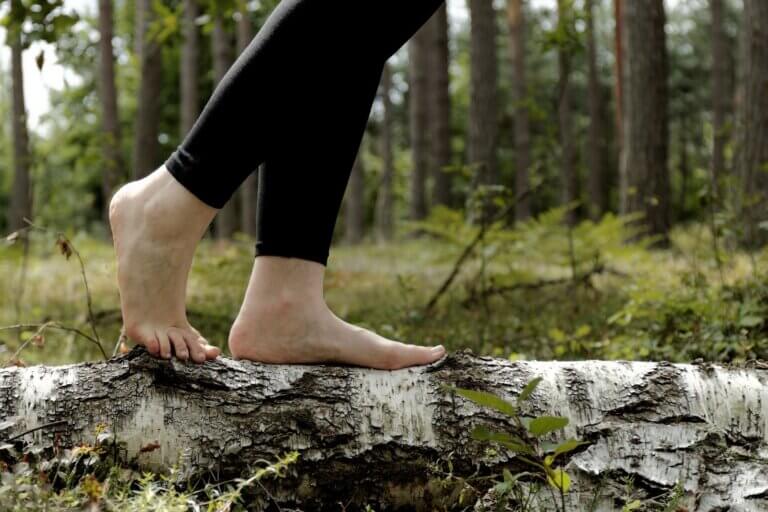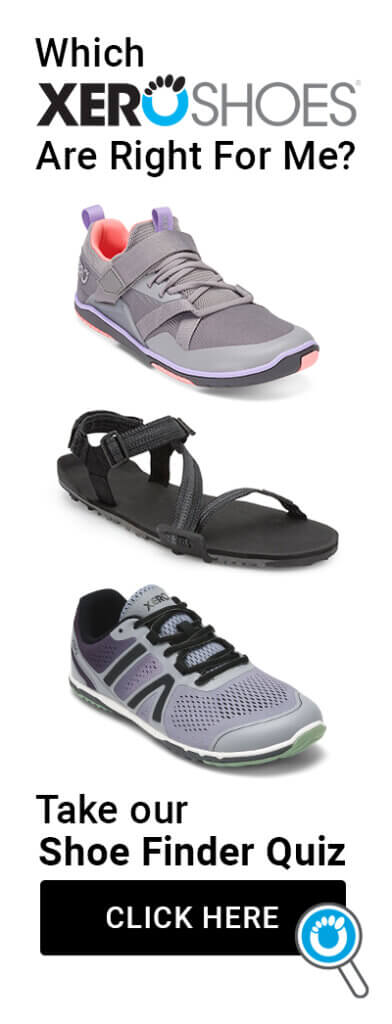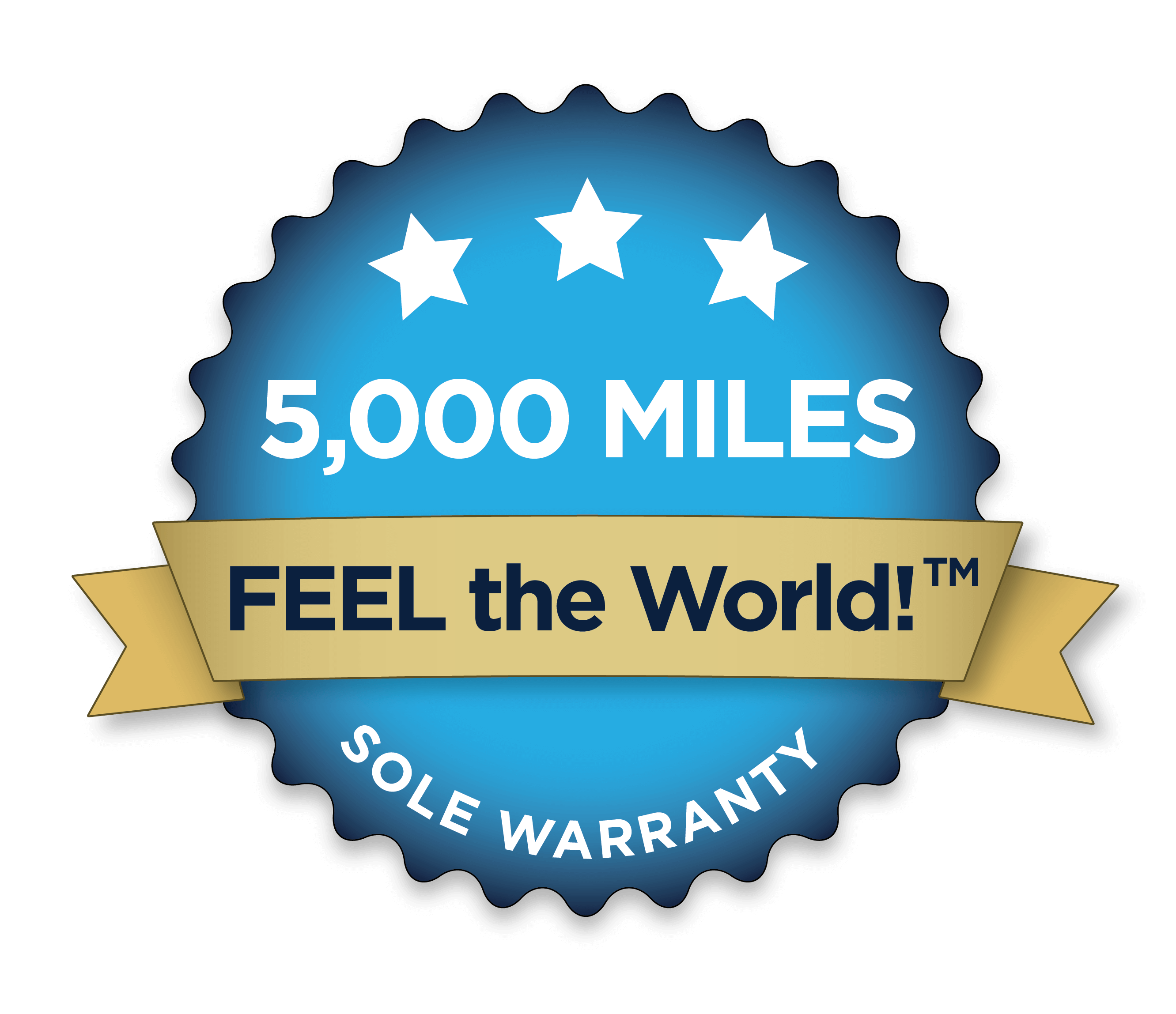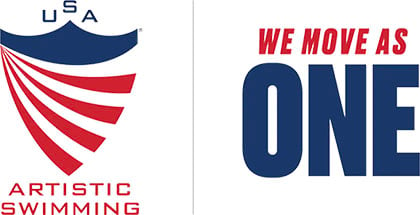
How To Walk Barefoot: Techniques & Health Benefits
Most of you will read the title and think, “Uh, I don’t need instruction about how to walk because I have been doing it my whole life!”
Others (hopefully) will think, “Finally, the answer to my burning question – have I been walking wrong this whole time?”
Whichever group you are in, keep reading to learn about the surprising benefits of barefoot walking (or the benefits of zero drop/minimalist shoes), as well as instructions to get you started.
What Is The Right Way To Walk?
For those of you who are skeptical that there may be a better way to walk, let me ask you this: Do tribal women in Africa with water jugs balanced on their heads walk in the same way that Olympic race walkers do? Do either of those people walk in the same way that you do?
The answer to both questions is obviously no.
That’s because walking isn’t just walking.
There are optimal ways to walk, just like there are optimal ways to throw a baseball, or do a ballet split leap.
That doesn’t mean there’s only one way you walk under all circumstances. Your gait will change if you’re walking uphill or downhill, accelerating or decelerating, walking fast or walking slow, or walking on different surfaces.
But there are fundamental principles that you’ll discover in this article which can make your walking more efficient, enjoyable, and simply better for your body.
How Going Barefoot Can Help You
While it’s possible to learn optimal walking form in shoes, it’s faster and easier to be in your bare feet to discover the best way to walk. That’s because:
- Most “normal” shoes get in the way of proper walking form. They squeeze your toes together, alter your posture with elevated heels, and are stiff enough to restrict your bones and joints from moving naturally. (more about footwear in a moment).
- When you’re barefoot, you get feedback from the ground which can help you find a natural, comfortable way to walk. In short: walking with proper form feels good, and improper form feels uncomfortable.
- Finally, walking barefoot can be fun. Especially if you have the courage to explore going barefoot in places where you’ve never felt the surface you’re walking on.
One other advantage: By walking barefoot, you become your own best teacher about proper walking form. Listening to your body will help you discover your own secrets for walking efficiently, enjoyably, and easily.
How Should My Foot Land When I Am Walking?
Some Youtubers suggest we’re built to have our forefoot touch the ground first. And there are some who say that you’re supposed to land on your heel when you walk (barefoot or not). They say, “That’s why we have a fat pad under our heel.”
Prior to the barefoot running boom and the publication of Born To Run in 2009, people rarely talked about different ways your foot can or should contact the ground. Now it’s practically dinner party conversation, where the barefoot gang looks down their noses in disgust at shoe-wearing heel-strikers, and shoe-wearers call the barefooters crazy hippies, and fights have broken out about whether landing on your forefoot is better or worse than landing on your midfoot or flat-footed.
So, which is it?
Well, the real answer is: Asking which part of my foot should touch the ground first is the wrong question 😉
What I mean is:
- Your footstrike changes based on whether you’re walking uphill, downhill, fast, slow, accelerating, decelerating, and what surface you’re on, and;
- Your footstrike will mostly take care of itself when you learn the most important aspect of barefoot walking, namely…
Landing with your foot underneath your body (or close to that) rather than having it land too far out in front of your body, which is called “overstriding.”
If you’ve explored barefoot running, you’ll recognize these ideas about walking are the same as for running. Where your foot lands in relation to your body, to your center of mass, is the most important thing.
And the way you learn to have your foot land in the right place is all about using your glutes and hamstrings properly when you walk… and that’s what the instructions, below, will teach you to do.
How Do I Train Myself To Walk Barefoot?
If you want to learn the natural way to walk, follow these steps for learning how to walk barefoot properly (and more enjoyably!):
Get Barefoot
Start by taking off those shoes, or get as close as you can to having bare feet. Incredibly, even socks can get in the way of the feedback you need to learn proper walking form.
You want to be able to fully articulate your foot and let your nerves feel the ground.
If you have to wear shoes, avoid shoes that get in the way of natural movement, namely, cushioned shoes, shoes with elevated heels, shoes that squeeze your toes together, and shoes that are not super flexible (e.g. you can’t roll them into a ball).
Instead, choose barefoot-inspired, minimalist shoes that are low to the ground, flexible and with a non-elevated “zero-drop” heel and a wider, foot-shaped toe box, like Xero Shoes.
Walk with your glutes, not your hip flexors
Your glutes and hamstrings are among the largest muscle groups in your body. They’re referred to as “prime movers.” But most people don’t use their prime movers.
Instead, when most people walk, they swing their free leg out in front of them by using their hip flexor muscles, and push off with the toes of the standing leg so they can then pivot over the front leg.
Try this technique instead:
- Lift your left foot about an inch off the ground. Through the next 4 steps, you want to leave that leg alone. Don’t swing it forward. Let it hang there, as much as possible, doing nothing.
- Now, imagine the motion of a roller skater or ice skater. When you skate, you push yourself forward by driving your standing leg backwards. When you skate, you drive your heel backwards, keeping it on the ground as long as possible. Doing this engages your glutes and hamstrings. That’s why skaters have great butts 😉
- Next, do that skating move, driving your right heel backward. Remember, don’t swing your left leg forward.
- When you push your right heel back enough, and don’t use your left leg, at some point – and you won’t have to think about it – your left foot will plant itself on the ground so that you don’t fall on your face.
- Look at where your left foot is in relation to your body. If you’ve done this correctly, you’ll see that it’s basically underneath you, supporting you, as your right leg is dangling in the air, pretty much where your left leg was in step 1…
- Now that your weight has shifted to your left leg and your right leg can hang there, with your foot about an inch off the ground, simply repeat the steps above but with your left leg’s heel pushing back in a “skating” motion, and use your right leg just to catch you and keep you from falling.
At first when you do this, you’ll be walking a bit like a robotic Frankenstein… sort of lunge-catch-stop-lunge-catch-stop.
Keep doing this until you get the feeling of using your glutes as you drive your heel back, relaxing the “swinging leg” and only using it to catch you at the last moment, landing with your foot under your body.
Then, smooth it out like this:
- Don’t push your heel back quite so far (but still use your glutes)
- When your front foot lands, immediately start driving that heel back
- See how much you can relax
As you smooth it out, you may notice that as you walk it can feel like you’re slightly falling forward.
This is fine.
In fact, it’s probably not true.
It’s probably that you were previously walking with your hips slightly behind your feet and, possibly, with your shoulders behind your hips (if someone were looking at you from the side, that is).
When you walk properly, it can feel odd simply because it’s not what you’re used to.
That “slightly falling” feeling means you’re using less energy. And it usually also means that your feet are under your hips and your hips are under your shoulders.
As you experiment this, you’ll probably find other parts of your body relaxing and doing less.
Listen To Your Body & Stick With It
Again, don’t worry about which part of your foot touches the ground first.
Gently rolling over your heel is fine.
Landing forefoot is fine.
Landing flat-footed is fine.
You’ll do all of those as you explore different surfaces, different inclinations, and different speeds.
For example, on hardwood floors I tend to land flat-footed or on my forefoot. On carpeting I roll over my heel.
Walking uphill, I always land on the ball of my foot.
Walking downhill I always roll over my heel (because the ball of my foot would land in front of my body which would be like putting on the brakes).
Because you are able to feel the ground now, your feet will provide feedback about what is and isn’t working.
This walking technique can help support your lower back, knees, hips, and your ankles. Your foot strike will take care of itself, and it will feel like you are walking on top of your feet rather than behind them.
Remember, this motion may feel robotic at first. As you practice and relax, it will become a smooth, comfortable, and efficient experience.
Are Minimalist Shoes As Good As Walking Barefoot?
Going completely barefoot isn’t for everyone and isn’t right for every occasion.
The good news is that you can walk in minimalist (or barefoot) shoes instead. That’s why we created Xero Shoes – so you can get all the benefits of being barefoot while still protecting your feet.
Xero Shoes are designed with a thin, flexible sole and roomy toe box so your feet can move naturally. This allows you to strengthen your foot muscles and safely get feedback from your environment similar to what you get in bare feet.
NOTE: Not all minimalist shoes are, well, minimalist
There are many footwear brands that advertise their shoes as “barefoot” or “minimalist.” And there are brands that advertise that they’re “zero-drop,” meaning that the heel isn’t elevated higher than the ball of the foot.
People often use minimalist and zero drop shoes interchangeably, which isn’t accurate, since you can have a zero-drop shoe with a stiff, or highly cushioned sole.
According do Dr. Irene Davis, the characteristics of a truly “barefoot shoe” are:
- A wider, foot-shaped toe box
- No arch support (more about that in a moment)
- Little or no cushioning (more about this, too, in a moment)
- A flexible sole to allow for proper foot motion
- A thin sole to provide proper feedback about what you’re stepping on or in
- Light weight
- “Zero-drop” on a non-elevated heel
According to Dr. Davis, shoes that don’t have ALL of those characteristics are “partial-minimalist shoes.” And her research shows that these types of shoes are the worst shoes to wear. That’s because, typically these shoes have cushioning that inhibits the feedback you need to naturally adopt a more ideal gait, and any heel lift will do something similar.
Xero Shoes, according to Dr. Davis, checks all the “barefoot boxes.” Plus, we make our soles more durable and back them with a 5,000 mile sole warranty.
In addition to our collection of minimalist shoes, we also make minimalist sandals and boots that you can wear anywhere from the office to the trail.
Can I Walk Barefoot On Hard Surfaces?
In a word: Yes
Humans evolved in places with packed mud that’s as hard as concrete (and with rocks and twigs and pokey things that you would never want to step on).
Your muscles, ligaments, and tendons are natural springs and shock absorbers. Better than any man-made cushioning material.
And when you land with your foot underneath your body, you can engage your arch (regardless of whether you have flat feet or high arches), to give you a strong foundation.
By following our technique, your feet will naturally learn how to handle hard surfaces just fine. However, there is, of course, a time and place for minimalist shoes.
Wearing minimalist shoes can help protect your feet from:
- High temperatures
- Sharp objects
- Potential fungal infections
- Places that require footwear
Have FUN!
One of the best things about walking barefoot is how enjoyable it can be.
Over time you may discover that surfaces you originally found unpleasant to walk on become your favorite natural foot massagers.
You’ll probably find ways to make your movement more efficient and feel parts of your body relax that you never knew were tense.
Learning a new movement pattern takes a bit of time to become habitual, and it’s a different amount of time for each person.
So, while you’re adjusting, use fun as your guide.
If it feels like work, stop. Rest. Then start again later.
Remember that your brain integrates new things when you’re resting, not by working harder.
So, use fun as your guide.
And, if you want to try Xero Shoes, start shopping here, or take our Shoe Finder Quiz and get recommendations for your new favorite footwear.

The information in this post does not take the place of medical advice. Only your doctor can provide advice, diagnosis, and treatment. Always consult a qualified health provider if you have questions about your health.







 Fostering honest and responsive relationships between businesses and consumers.
Fostering honest and responsive relationships between businesses and consumers.














Another great form of feedback is walking on icy roads/sidewalks. I’ve found that since I switched to minimalist shoes, 2-1/2 years ago, I can comfortably walk on ice (at least moderately level roads/walkways) with great confidence where as heel striking is almost guaranteed to put you on your butt. I know instantly if my form gets sloppy because my foot will slip. If I keep my feet landing beneath me and on mid/forefoot I can move along at a normal (for me) walking pace. My wife and I do regular hour long power walks on our unsalted country road in the Northern WI winter with confidence. In the past we had to wear those spiky shoe covers to keep us upright.
That’s a great one, Scott.
You’ll love this video that shows someone running across ice. The video shows that, at full speed, most of the force is vertical an not horizontal, because if it were horizontal force you would slip and slide.
http://www.bearpowered.com/resources/videos/iceman/iceman.html
Honestly probably the best articles I’ve ever read regarding barefoot walking. The difference in forcing your foot in front of you and using your glutes is subtle but significant.
Nicely written piece there Steven.
minimalist shoes..yeah, Avia & other major manufacturers who make expensive shoes in Vietnam. Walk barefoot..just do it. it takes awhile to get used to barefoot, but ohhh, it feels nice. you sleep better.
I have a pair of Xeros for joy, and Vivobarefoot minimalist shoes. I am a teacher of The Alexander Technique which is the initial impetus for the whole Barefoot Running Movement ( 20 yrs ago or some such). Your advice re Walking barefoot ( or any other way) is insane, impossible, and does NOT conform to the natural human walking pattern. Suggest you contact RICHARD BRENNAN , trainer The Alexander Technique, (Ireland) or myself , or read THE ART OF WALKING author Marguerite Osler.
Can you be more specific? Which part is “insane”? Which part isn’t “natural”?
“everything I do is perfect in every way, nothing you do is acceptable, Stephen.” “Buy my book and shut up, you nitwit…”
Ah, NOW I understand 😉
One thing is for sure: what you just described is by far the most *elegant* way of walking – a high-heels kind of look in a natural and harmless way. Cheers!
I don’t understand a word of this. I’m dyslexic. If I stand on one leg, nothing moves. If I contract muscles I’m still standing on one leg. Please explain step one, step 2 , etc for dummies. (BTW THE spiralling of the torso seems to have more to do with correct mechanics than thinking about the legs)
I’m not sure what dyslexia has to do with it… but if you only contracted your glutes and hamstrings, they would shorten which would push you forward just enough to initiate walking.
The gist is: don’t sit back over your feet; don’t just swing your leg out in front of you, plant it, and push yourself over it.
OK. I’m standing on one leg. The other leg is suspended in the air. Now what??|
Are YOu saying to contract the glutes and hamstrings of the standing leg? All that happens now is I fire up my core.
Do You mean fire the muscles of the suspended leg? Can’t do it.
So you must have something elso in mind.
It Helps me to have instructions like. “StaND On one leg. Place the other foot behind , resting on heel, then….”
PLEASE describe EXACTLTY WHAT you do, including every placement, focus, intention for one complete step cycle, including what should be noticed when doing it correctly.
PLeaSE start with this, thanks
“Yesterday I was clever, so I wanted to change the world.
Today I am wise, so I am changing myself.”
-Rumi
Yes, I mean the leg that’s planted on the ground.
It is possible to contract the glutes and hamstrings without firing the core (in the same way you can isolate any muscle).
But try it upside down… TRY to move forward while standing on one leg, without leaning forward (from the ankle) or bending forward (from the hips).
The only way you can do that is with a contraction of the posterior chain, the prime movers, a.k.a. the glutes and hamstrings.
Let me add… it’s not like contracting the posterior chain THROWS you forward. What it does it that it makes a minor change in the position of your hips, which moves your center of gravity SLIGHTLY forward… enough that if you did nothing else (like put your other foot down), would cause you to fall forward.
And it’s not like you do a HARD contraction when you walk.
For some, this is really more of a “cue” to get you “on top of your feet”. And for people who haven’t really used their glutes in a while it may be that you need to do things in reverse: Position yourself so that you’re “on top of your feet” and walk with that posture and you may feel your glutes firing in a way they haven’t in a long, long time.
Stephen-Let’s start again. What do you mean walk “on top of your feet”? What is NOT WALKing on top of your feet. Maybe somebody else can explain this in step by step child language for someone completely ignorant of the subject.(Show your replies to a ten year old and see what his response would be)
“On top of your feet” was something that customers of ours used as a description.
It has to do with where your center of mass is as you move. If you lean back slightly as you walk, your feet are sort of out in front of you… you’re “behind your feet.”
If, when you walk, your front foot lands under your center of mass, it feels like you’re “over your feet” (comparatively).
Perhaps a video will help. I’ll try to make one soon.
Here’s another image that can help, especially with the glute/ham contraction thing:
Either lie face down on the ground or imagine doing so.
By contracting your glutes on the right side (not by arching your back, that is), raise your right leg a TINY bit off the ground. Then notice that you can actually use your glutes more and raise your leg even more.
When walking, many of us only do the smallest extension of the leg behind us. We don’t use the glutes to push us forward. And the glutes/hamstrings are at their strongest when we use them that way (muscles are strongest in the final degrees of their range of motion, when they’re more fully contracted).
So, back to the standing on one leg thing… if, while standing on one leg, try to “raise” that standing leg behind you like when you were lying on the ground (which you do by contracting the glutes/hamstrings), it propels you forward.
If you relax the other leg, but use it to keep you from falling on your face, you’ll probably find that you simply place it (perhaps a bit flat-footed), under your body rather than reaching out in front of you. Then “raise” that leg behind you and repeat.
Again, many people describe this as feeling as walking “over their feet” because of where their feet land in relation to their center of mass.
Fingers crossed that I’ve done a slightly better job with that description.
As an aside: For people familiar with running biomechanics, what I’m describing is the difference between front-side and back-side mechanics in walking. Just as distance runners have more backside mechanics, that’s a smoother, more efficient way of walking as well.
Look’s like he’s pushing you into doubt by picking at the weaknesses in the language of bio-mechanical theory. Not anyone can take a theoretical explanation of something as particular to the individual as walking and easily apply it to practice. Certainly, even the most astute of minds will not completely comprehend your aim. In any case, this is one of the best articles I have read on the subject, but it may easily confound the masses.
When done correctly a person moves faster and looks like they are loafing along.
I tried it in my living room just now, and it was so easy I wonder if this is what you mean. I found myself taking shorter steps and kind of shuffling along, with my feet much closer to the floor. It felt good. In general, my hips hurt (arthritis-type thing), so I am going to try this way of walking outside to see if it makes them hurt less.
Can you please .ake the video? I still have no idea how to do it after reading the article and comments many times 🙁 When I stand on one leg I can’t move forward. It’s like a reflex to stay balanced and not let myself fall. Idk what to do.
Hi Narek,
I’ll try to get that video up as soon as the Shark Tank effect slows down 😉
And, of course you can move forward on one leg… the whole point is that you’ll put your other foot down so that you WON’T fall. And when you do, you’ll put it closer to your body rather than kicking it out in front of you.
This was great! Thanks for the clear — and engaging — explanation.
Great Article – Thank you! I’m a BFRunner and JUST started to worry about how I should be walking in my vibrams or barefoot. This clears things up nicely. Cheers again!
Andy from
http://www.myrunningtips.com
Great and informative article, we have been practicing bare foot walkingrunning for a few years now, and lately combining Barefoot & Breathwalk …. results are amazing in terms of stamina, mental clarity, physical wellbeing, focus, creativity… rejuvenation…. it is a WOW match made in heaven 🙂
http://www.abruzzopassion.com/BreathWalk.html
Steven,
Like Laurence I also fail to understand the idea of moving forward while standing on one foot. You say not to bend either at the ankle or hips, so to my way of thinking that leaves no possibility whatsoever for movement. Am I missing something? Everyone else here seems to get it, but I (and Laurence) sure don’t.
You’re missing something 😉
To be technical, you’re going to put the hip into extension. Think about driving your heel backwards (while it’s still on the ground). To do this, you’re using your glutes and hamstrings.
I too am having trouble understanding the walking technique. I can stand on my left right leg and contract my right glute and hamstring. My left (suspended leg) moves forward maybe a quarter of an inch. I can place my left leg down and raise my right leg. Contracting my left (support) glute and hamstring moves my right leg maybe a quarter inch. I can’t imagine getting anywhere only a quarter inch at a time. I tried laying down like you suggested to Laurence. Contracting one glute does shift my hips significantly but I think that is more because my “rear” has changed shape and essentially pushed back against the floor to shift my hip.
Try this cue instead:
Push the heel of your standing leg backwards, while keeping it on the ground.
(What allows you to do this is contracting your glute/ham)
I can contract my glute just fine. It just barely moves my opposite leg though. I feel as though in order to get any distance in my stride, I need to move the lower half (I.e. Below the knee) of my suspended leg out and away from my body a bit.
Contracting your glutes has no effect on the opposite leg, nor is it supposed to.
Driving your heel back is what MOVES you forward. Your opposite leg does very little (which is why this as an efficient way to walk).
And you don’t need ta create distance in your stride by reaching out. Try using the distance that takes the least effort. It may be shorter than you’re used to.
Hmmm. I was just thinking… Let’s go back a step to help understand. There are a couple ways to pick up a leg to be on one foot which produce very different effects. The thigh bone in a normal standing position is perpendicular to the ground. I can pick up a leg by moving my thigh bone up in front of my body and making it parallel to the ground. If I do this, I can have my lower leg either very relaxed which puts my elevated foot almost next to my support knee or I can have my lower leg contracted such that I am making a near right angle from my upper to my lower leg and my foot is going to be in front of me. I can also lift up my leg such that my thigh bone stays nearly still and remains near perpendicular to the ground but my lower leg moves back and my foot goes behind my body. When you first talk about standing on one foot, which of the three methods are you referring to? (Or do you mean a fourth?)
I actually was not talking about the non-weighted leg with the cue I gave.
And there are different stages of the gait where you’re doing different things with the non-weighted leg.
The simplest answer I can give: Do as little as possible. Relax as much as you can. Don’t reach out with the non-weighted foot, but let it drop under your center of mass so you don’t fall on your face 😉
What I’ve seen is that if you focus on the weighted leg, the non-weighted leg usually takes care of itself.
For the sake of this experiment, though, to START walking, I just flex my hip and relax the rest of my leg. And I flex so that my toes are about an inch off the ground. Again, that changes with the 2nd step since the foot that’s about to become non-weighted will be behind you… so go back to “relax and focus on the weighted leg.”
Maybe I can help a bit here. What I think helps is to understand that your muscles strength turns out really different for different muscles when you do that for a while. So if someone says “contract your glutes” and you think you do, does unfortunately not mean that they are strong enough to DO what is supposed to happen. So you might do the right thing but simply not have the strength for the necessary effect yet. Which will change over time!
I’m walking barefoot for many years now where ever possible as I had problems with feet muscles as teenager and translating into back pain and all and I’ve been using very soft, thin soled shoes from physicians recommendation for over a decade now. By now using normal shoes feels very awkward for walking style and I get exhausted as my muscles are developed for barefoot – but no longer for heel based walking. My shin starts hurting when I wear hiking boots for example for more than two hours. Of course I can do “normal” (heel based) walking, but it seems very inefficient as I lack the training. So please don’t feel frustrated from the description, this isn’t some magic thing that just works because you change technique, the muscles need to strengthen for this type of walking to become efficient. For some more than for others, depends on individual walking styles too.
Now a bit more specific at least from how I’m walking by now and trying to further explain what I think Steven means: If you stand on your right foot, weight on it, left foot just lifted a bit in the air but still below your body center … bend the right knee a bit so it is not locked. You will already at this point feel if your glutes and hamstrings are trained enough to keep that comfortably or are under strain. Now contracting your glutes and hamstrings is not about making a tight “butt” but your foot muscles are part of this too. So actually what it does (if the muscles are strong enough, leaning forward a tiny bit can help) your ANKLE pulls up. I know it sounds like just push with your foot up, but that is really only part of it, contracting the back of your leg is pulling the ankle upwards too. So you stand on your fore foot from it. And that is the whole push which makes you “fall” forward, where you land with your left foot (fore or mid foot again). Instead of pushing your left feet forward, leaning and then heel first land there, dragging the right foot behind which remains under your body.
So short version:
a) barefoot: keep free foot under body – bend knee of weight leg slighly – tighten muscles of back of weight leg so ankle comes up, pushing the body slightly forward – keep free foot moving with/under body by keeping it relaxed in the hip – land on fore/middle foot of free foot = force comes from the back of your weight leg (muscles will strengten, moving forward gets flexible and steps longer and easier)
b) stiff shoe walking: swing free feet in front of body – lean forward to follow free foot – land on heel of free foot – drag weight foot along
It really takes a while for the muscles to become strong enough so the contraction of the back of your weight leg is doing something to the ankle/foot. but you can help it by pushing up with your feet too, that is the other point of barefoot walking after all: strengthening the muscles of your feet structure a lot. It is not just gluts and hamstrings! And trust me, there is a lot of muscle there that is not very much trained otherwise, my massage therapist is always amazed, she did not know I’m a barefoot walker but she told me the first time already that she never had someone with even remotely so dense glutes, hamstrings and loin muscles. And we don’t talk muscle knots here.
Maybe that helps.
Didn’t fully understand until I stood up and tried it. Fantastic!
You provided a great explanation for barefoot walking. I just gave it a try. It was a more graceful way for walking with MUCH less shock to the body.
I’m not sure where to post this question, but this seems like as good a place as any. It seems to me after wearing these shoes for about a week, that they are super awesome if you are walking or running on the Earth (grass, dirt, etc) but that they are not so awesome on pavement or other hard surfaces. In fact, when I have worn them around town where I was walking on concrete, my legs and feet hurt quite a lot after even an hour or two. Am I just really sensitive or have other people experienced this? Obviously I would prefer that so much of the world was NOT paved and we could walk on soft surfaces all the time, but unfortunately that is not the case. How do you other barefoot fans deal with the concrete issue?
Funny you should say that… my wife and I just came home from a 2 hour walk on pavement. 😉
If you look at https://xeroshoes.com/barefoot-running-tips/how-to-run-barefoot/ you’ll see that one of the first tips is: run on a HARD surface. The reason: it gives you the most feedback about your form.
I don’t know if you’re “sensitive”, but it sounds like your form isn’t yet adapted to harder surfaces. That is, you don’t need to get stronger to handle hard surfaces, but you may find that as your form adjusts, you use less effort and muscular force.
For now, use the same advice we give for getting started with running: START SLOWLY. Do a little at a time and build up your time based on how good you’re feeling.
I’ve been using my xeros for over a month now, and have no problems at all except…
I always seem to develop a blister on the side of my right heel whenever I spend more than about 45min in them.
I’m pretty sure I heel spike a bitbut even trying these the closest I seem to get is more like a stomp.
Any advice would be great 🙂
Emilie, take a look at http://www.xeroshoes.com/blister — the simplest thing I can say is: if you’re getting a blister on your heel, you’re not only heel striking, but adding EXTRA horizontal force on that spot.
The only “advice” is to experiment with your gait and stop doing what causes the problem. If you use the instructions on this page, you *should* land more flat-footed and then have less horizontal force on the ground.
Will give it a shot. Thanks
Great article. My previous comment got lost somewhere. I recommend an outline or bullet chart as a lead in to keep people focused on the whole process. if the big picture is seen first the details will sink in.
Great idea. I’ll get to work on it when I have some time.
I’m working a retail job for the holidays and how I wish I could get my (mostly) just standing form and footwear down so my back (from my neck down) wouldn’t hurt so much.
I am working retail for the holidays. I’m trying to get my (mostly) standing form and footwear down to relieve the back pain. Four days in various (as close to barefoot as I’ve got ) shoes and none seem to be any different. Not sure how to “get away with” wearing my xero shoes.
Add REALLY contrasting socks so you’re not hiding them! 😉 Or, get green soles and red laces to blend in for the holidays (or red soles and green laces).
BTW, the reason being barefoot should help with your back is that when you can’t use your feet to balance you, that job goes “upstream” to your knees, hips and back… which aren’t built for that job. Let your feet work correctly and they can take the stress off your back.
Thanks so much! Maybe Xmas socks with Xero shoes will be upcoming in attire!
Wearing-bearing movement, such as walking or using the elliptical, with a
more minimalist shoe Begin to incorporate short intervals (seconds
to minutes) of barefoot walking around the house while continuing to use minimal shoes walking or on the elliptical..
http://www.footsolutions.com/store/bethesda
walking like this makes me feel like a dinosaur
Smooth it out and use a bit less effort and you’ll find a way that feels natural (because it IS a natural way to walk 😉 ).
How about a video? :$
Even though I’ve vowed not to make a “how to run barefoot” video (so as not to encourage people to think there’s ONE way to run), I may do a walking video. Once it warms up here in Colorado, I’ll see what I can do!
Good. Looking forwad. It would be nice to see the exercises ’cause something can be missed in translation…
I missed the webminar, and I was so going to ask about walking.
This reminds me of chai walking. It could almost be described as falling forward and catching yourself although not really. That kind of walking leaves less of a foot print which to me says less harsh impact.
Agreed on all counts!
hello, I should be getting your shoes shortly. Any chance you already have a video of good barefoot walking?
I don’t have one up at the moment. The challenge with posting “here’s what it should look like” videos is that:
a) Two people doing the basics correctly can still look different, so do you emulate one, the other, or neither?
b) Most people don’t have the body awareness to know if they’re actually imitating what they see in a video… so without video analysis software (like Coach’s Eye), using video as a guide can be challenging.
Ideally, using the basic instructions/concept along with your own sensations will be your best teacher.
That said, I’ll see what I can do about video. 😉
thanks for the reply. Perhaps just a short video to demonstrate what you call “basic”? Just to show what you meant in your written guidelines (using glutes and hamstrings)
thx
Let me see what I can do. There’s not much to show, though: while standing on one leg, drive the heel of that leg backwards… let your front leg relax and only place it on the ground to keep yourself from falling on your face. Then repeat. 😉
This ia interesting but I’m still a bit confused. Should I be trying to land on the ball of my foot as I stride instead of the “traditional” heel strike? Should I be flexing the ever living you-know-what from my glutes and hams as I walk? i really want to not get blisters on my heels from these shoes 🙂
Which part of your foot touches first is less important than where your foot lands in relation to the center of mass of your body.
And, no, you don’t need to “over-flex” your glutes/hamstrings. It’s that if you USE them as the prime movers and RELAX the leg that’s in the air, you’ll end up placing your foot under your body more than in front of it.
Usually that means you’ll land a bit more flat-footed. But depending on your speed and whether you’re walking uphill or downhill, that’ll affect whether your heel touches first or your midfoot does.
For the same reason we suggest starting SLOWLY by running for 30 seconds, or about 200 yards… and then increasing by 10-30 seconds on successive runs only after you’ve had a fun, easy, injury/hot-spot/blister-free time, we suggest the same thing for walking.
So, I’d try doing less the next time you’re out and experiment to see how to NOT get those hot spots. See http://www.xeroshoes.com/blister for some hints.
Now, that said, here’s another way to think about how to properly use your glutes/hamstrings. Stand on your left foot and lift your right foot 1/2″ off the ground, straight up (you’ll have to sort of twist your hip to do this). This has nothing to do with how you walk… just something you need to do for this exercise.
Now, keeping your right leg straight, and without arching your back, move your right heel backwards. You should feel that in your glutes and, possibly, hamstrings, too, because the only way to make this motion without arching, is by flexing your glutes/hamstrings.
Now put your right foot back on the ground and KEEPING it on the ground, try to do the same thing… this will propel you forward. Keep your left leg relaxed as you do so (don’t swing it forward) and place your left foot on the ground, under your body, just so you don’t fall on your face ;-).
Then repeat the same thing with your left leg, driving the heel back, relaxing in the right leg and letting the right foot land (it’ll probably be a bit flat-footed) under your body.
Smooth it out and then use as little effort as possible (unless you’re in the mood for a glute workout, which is fine), and see how it goes…
First I would like to mention what a great product and service you are providing for people. I have been training in Ninjutsu, a martial art, for over 15 years. For that time I was taught to train barefoot. It is nice to finally have something that is socially acceptable in public compared to just being barefoot. I always got funny looks when I was wearing my custom suits with no shoes on in our business meetings. If people would like to wear Xeroshoes and have them seemingly be un-noticed in business setting’s I find that when I wear my tabi socks with them nobody even notices.
I am currently having some medical issues with my spine and having a very difficult time walking barefoot, something I have done on a daily basis for over 15 years. I am 230lb at 10% body fat with my thighs measuring 27in. When my physio therapist examined the sequence of my posterior kinetic chain he mentioned I would fire of the hamstring then proceed to the lower back, completely skipping engaging my glutes. They now have me walking in these ridiculous spring loaded super heel shoes.
My foot still lands underneath my center of gravity. But for some reason I am always engaging my hamstrings and not my glutes. I am able to straight leg kick a 6ft tall guy in the chin, which indicates I have flexible hamstrings. But they are always very sore and over used.
Could you please help me enjoy the benefits of being barefoot again? Possibly provide me some information on the sequencing of what muscle’s are engaged when walking or the desired bio-mechanics. It is as if my brain forgot how to walk & I need to re-think how to do it again. We took a video of me walking, my entire body appears to just have shut down the neurological connections. That’s the last time I try to catch an arrow being shot at me with my foot.
Maybe some reference exercises to strengthen the glute muscles needed to be engaged for walking? Anything would be greatly appreciated.
Thank You.
Hi Asura,
Thanks for your kind words. We’re thrilled to be able to give people a barefoot alternative that’s still as close to barefoot as possible.
Onto your issues…
First, unless your physiotherapist hooked you up to an EMG machine and measured your glute activation while you were in motion (walking, running), s/he can’t make the diagnosis you’ve described.
Secondly, it wouldn’t be helpful to describe some idea of how and in what order your muscles should fire when you’re moving. In part because it’s not a simple on-off/on-off/on-off sequence, and in part because, like the testing, unless you were doing real-time EMG-based biofeedback, you wouldn’t be able to do anything with that info anyway.
Regarding using your glutes when you walk. Try the experiment I mentioned earlier… stand on your left foot and, with the RIGHT leg straight, drive the heel back (this can only be done with the glutes). Relax the right hamstring as much as possible and really feel the right glute work at the end of the range of motion.
Then stand on the right leg, bend at the left hip flexor and relax the left knee so that the left foot is about 1″ off the ground. Then drive the right heel back, just like you did before, only this time it’s on the ground… this will propel you forward.
DON’T reach out with the left leg when you do this. Just relax it. You’ll naturally place the left foot on the ground, under your center of mass, so that you don’t fall on your face.
Then reverse the process, driving your left heel back by using the left glute.
Repeat and smooth things out so you don’t look like a zombie… then use less effort over time.
For glute strengthening, go to youtube and search for “bret contreras glutes” “bret contreras hip thrust” and “chad waterbury glutes”
Finally, I want to see that arrow-catching foot video! 😉
I have a question. I got custom xero sandals, and I wore them all day for 4 days in a row and then i noticed my feet were swollen. Is that normal? Now i’m taking a break from barefoot walking for a week. Next day when I wore normal sandals, my feet swelling went down. Should I wear the xero sandals less, or progressively, or should I ignore the swelling?
I’ve never heard of this, in over 5 years and with over 50,000 customers, so swelling is not “normal.”
My guess is that you’re doing something different when you walk in Xeros… so I’d follow the same instructions about starting to run barefoot, namely, wear your Xeros for less time/distance (only a few minutes/day, tops), until you can do that comfortably… then increase your time/distance.
And pay attention to what you may be doing differently when you’re walking in your Xero Shoes… that might give you a clue about what to do differently.
Daniel Lieberman, author of The Story of the Human Body: Evolution, Health, and Disease, along with 3 colleagues at Harvard, have conducted research into the biomechanics of walking and running at the Skeletal Biology Laboratory. They are avid supporters for barefoot walking and running. If you’d like more scientific information, here is a link to their website: http://www.barefootrunning.fas.harvard.edu/ Happy Trails to You!!!
This is pretty amazing, I have serious low back issues and just trying a couple steps “on top of my feet” made such a difference in reducing the back pain that I feel round the clock. I’m definitely going to keep it up!
It would have been great for those of who doesn’t understand English as well as you, to have some visual clues!
Working on it…
Perfect description, thank you! I knew I should squeeze my glutes while walking, but I didn’t understand why. Oh yeah, because they are doing the work, not just for the sake of squeezing them! A big help as I learn to rethink walking because of my bad back. I will be using this info in my blog, and I will definitely link your article!
Hey there! This is great advice, thank you for sharing it. I’ve been noticing some pain in the top of my foot since going the minimalist route…is that a common complaint you hear? If so, does there usually tend to be a common error in form with it?
Never heard this case of pain in the top of the foot. Do you run barefoot or only walk? What minimalistic shoes do you wear? Just curious.
Don’t mean to cause unnecessary fear, but it can be caused by a stress fracture from too much to soon. The premise is to learn to walk barefoot before you run barefoot.
You make a lot of relevant points in this article, thank you! I have a chronic cervicalgia and went full barefeet (and vibram five fingers) after reading Whole Body Barefoot from Katy Bowmann, this has helped a lot. But I’m still trying and exploring several variants of barefeet walking, your ideas was what I needed! 🙂
Good luck Jeannette in your search to improve your bad back.. Let us know if you find a way to walk that works for you! Cheers
I think I found myself doing this back when I was first hiking in my ridiculously heavy and now disused Lowa boots. They were so heavy at the end of the day that my turbo hiking mode was to transfer my weight to the front leg, fling myself forward with the glute and hamstring combo, lightly position the rear leg in a forward position under my center of mass (imagine a we noodle that that gets tensed before weight transfer), and repeat. I was really surprise that it was way faster and more efficient than my strides at the start of the hike. I’ll have try adapting the technique to a more controlled barefoot walk.
Thank you so much for this video and the posting – exactly what I was looking for. The past six months have been a huge shoe drama, then feet drama, presently knee drama (or muscles not previously used as a kind Chiropractor is educating me on…) since my then, ‘before-I-knew’, best-loved “rocker” shoes finally wore out.
I realize now, I don’t know how to walk so am very grateful – three weeks until I leave for a glorious trek in Tibet and your sandals which seem so thin but oddly don’t hurt my feet, are coming with me.
I’ve been searching the net on how to walk barefoot properly since I commented on a xero shoes video last week about the pain I have while wearing their Venture sandals. They sent me some great info, including this page, but I am trying to find something more visual. Images or a video that shows me exactly what I should be doing (or close to it). It’s been a struggle to find content other than words. I’m a very visual learner. If anyone has a great barefoot walking video or images I can look at, that would be great. Thanks in advance.
Hi Beth-Anne. Here is a video I just posted on Youtube that can give you a visualization of what is happening with barefoot walking. I believe what most people, including this article, ignore is that walking is not just an activity done with the hip and the legs. What we do with our abdominal core is critical (that’s why your arms swing when you walk), and it is the change in your core movement that actually affects where your heel places and how hard it places. Barefoot walking shortens the stride actually by changing the timing of the rotation of the abdominal core, placing the foot down sooner during the course of the leg swing phase. This also has the effect of placing the foot slightly more on the padded aspect of the heel.
https://youtu.be/z7Ae9olZfcs
Hey, Todd… I love what you’re doing! BTW, it’s not that I’m ignoring the core, but I’ve found that most people can quickly alter their gait into something more natural that puts less stress on the body by first attending to the points I raised above.
Thanks Steven. I agree fully. You have to start with some quick tips. Connecting it to the core can be a challenge. I just rarely hear the core mentioned so I wanted to put in a plug for people trying to get connected to it.
I’m working on a video… but I don’t have an ETA yet. When it’s done, I’ll simply add it to this page (and announce it in our newsletter).
Thank you Steve,
It was fantastic to read your article.
I’ve been moving barefoot for nearly 7 years now and what you said has come as confirmation to the evolution of my experience.
Thanks again!
Mark
Hi Steve, great article! It confirms my own experience a lot with what I call fox-walking as learned from the tracker world. I live in the woods in a Norwegian log house together with my hunting dog. Walking and running forefoot makes me feel like a wild animal – as a hunting wolf. It’s a very bold experience – turning my body on. It’s like feeling the strength of our ancestors can make you more stable and balanced and result in enhanced immune, physical and mental robustness.
My own footware story includes Vibram fivefingers, then VivoBarefoot minimalist shoes – and now Z-Trail running sandals. And I confess – I’m in love 🙂
This barefoot paradigm has also influenced my favourite sport, the game of tennis. After having used my fav Prince tennis shoes for 15-20 years or so, I then tried all kinds of footwear on my favourite surface, the hard court. I can tell you that nothing compares to playing barefooted on hard court! It makes it somehow more natural to use the power of your whole body – a strong, ressourcefull, resilient and explosive ‘kinetic chain’.
I made a short footage on court:
https://www.facebook.com/misha.sakharoff/videos/10212774074679069/
I have had pain in my left heel when I walk, for the past few years, to the extent that I gave up hiking and walking my dogs. The podiatrist says that it is because I have lost the fat pad on my heel and I am walking on bone. For years, my walking style was to crash with all my weight on my heels. The most comfortable shoes I have are some cushy sandals. Should I try to walk on my forefoot then? I got Vibrams a few years ago because they force me to not crash my heels but I feel really geeky if I walk landing on my forefoot first. Any weight on my left heel causes pain though.
If you focus on having your foot land “under” your body, the footstrike will take care of itself. Most of the time you’ll land midfoot. Sometimes you’ll land forefoot. Rarely will you heel strike, but when you do you’ll be rolling over the heel more than STRIKING.
I can’t say much more without knowing more about the pain itself and seeing you walk. But the fact that it’s only happening on one foot makes me doubt the diagnosis you received and think that it’s more related to form and, possibly, a tight calf that pulls on your heel. See http://www.xeroshoes.com/blister for a story about my “unilateral form issue.”
Thanks for the blister article. I really do think the diagnosis is correct. I have had X-rays and several exams. You can feel the heel bone under the skin, and the pain is there even just standing on it. I will try to pay more attention to what you have advised, but it seems that I just can’t put weight on my heel. I am afraid that if I avoid stepping on the heel though, my calf will shorten. At least the barefoot shoes keep me from crashing onto my heel, I guess that is a good thing.
Try sleeping with toe socks on. You may have to remove them in the middle of the night of you feel strain, but they have cured my arch pain and may help with other problems.
I appreciate that you took time to write this blog about how to walk barefoot…Awesome work go ahead and a great video. Keep it up!
I’ve been walking on barefoot shoes exclusively for about a year now but lately experience pain in the ball of my left foot, from what I can find might be metatarsalgia. My left is not my dominant side and this seems important: I notice that when I walk, I use my right foor a lot better, I land more gently on the heel/mid-foot and ‘roll’ my foot towards lifting it with more control. My left foot I slap onto the ground a bit more, there’s less control but I use that foor for propelling, so I use the ball of the foot with more force.
I’m trying to find information on metatarsalgia and minimalist hoes but can only find stuff on running barefoot, not walking. I’m not a runner! I am a yoga teacher though, and I have at least somewhat strong feet and I use them with awareness…. I’m just puzzled at why I have this issue now! I really want to keep walking on barefoot shoes, I love it.
Does anyone on here have any suggestions, bright idea or pointers as to where to find more information?
Thanks!
I forget to mention, that the left foot has a slightly fallen arch as well. And apologies for the lazy spelling!!!
Hi. Need some advice for a new minimalist.
I’m 13 days in on minimalist shoes and it has been eye opening so far. I’ve been fairly aggressive user, bought TerraFlex for home and Hana shoes for work. I just ordered cloud sandals as well. Im a walker/hiker with 2 bad knees (chondromalacia). Ive spent about 90% of the 13days in the Xero Shoes or barefoot and have walked upwards of 100 miles ( I also have 2 young dogs!) knees are doing great! Also discovers that my daily morning stiff heel pain went away – I thought it was age related but reading suggests it may be plantar fasciatus – so thanks Xero! Maybe you fixed a problem I wasn’t even aware I could address.
I should also note that I’ve observed a tendency to ‘heel strike’ my lead foot /right foot despite my concentration, thus my right foot is a little soar.
Following recommendations, I’m trying to wear my traditional shoes intermittently but having trouble knowing ‘how to a walk’. Is there a recommendation for how walk when wearing traditional shoes?
Thanks for any advise . Thomas
The idea is basically the same. Land with your foot as close to “under” your body as you can.
Your heel may touch first, which is fine, but if it does you want to roll over it rather than STRIKE with it.
Wearing a size 17-18 shoe, I’ve been making and wearing my own sandals using Xero accessories and have noticed a huge difference in the way that my feet look and feel. Many shoe companies take shortcuts when extending their size range (think toe boxes that are three sizes too small), so it feels great to finally wear shoes that truly fit and allow me to run/walk/move as intended. I wear boots for work and have gone so far as to have a cobbler replace the heavy sole and heel with a zero-drop 4mm sole to keep the benefits going while I’m on the clock. The only downside is that pebbles and other debris tend to get stuck in my DIY sandals. I could really use a sandal with a rim on the heel and sides or a close-toed athletic shoe that is truly barefoot. As you mention in the article, even minimalist running shoes that I’ve found in my size still have a drop and arch support that doesn’t match up to my feet.
Any chance of extending your size range? I know it’s a complicated endeavor that requires major supply chain, marketing and financial decisions, but you have an incredibly valuable product. I’m pretty sure I’m not the only person with larger than normal feet that would be willing to pay a little extra.
We’re looking to expand the sizing, but I’m not sure about going up to 17-18. As you know, there aren’t a lot of you guys out there 😉 … and each size costs us many thousands of dollars to develop and manufacture. As Xero Shoes grows and we have more reach, that becomes more cost-effective.
Wow! I have read sooo many things about “how to walk barefoot,” what your “foot strike” should be like, etc., but trying to follow their instructions always felt super weird and awkward, and I never felt like I was doing it right. This is the first explanation that actually made sense to me AND when I tried it it felt easy! It is VERY different from how I normally walk, so I will have to practice a bit to get used to it, but I actually understand how it is supposed to feel now, and it feels good! Thanks so much – this will help me enjoy my Xero Shoes even more, I’m sure. 🙂
I just started with the shoes and my second toe on my dominant foot hurts. Any thoughts as to what I am doing.
I have paid attention to see if I am walking differently with each foot and I am not.
Without seeing you or having more information, I don’t have a good answer. If you’re confident that both sides are the same, that makes it trickier (I don’t know anyone who is symmetrical, but that’s a whole other story 😉 ).
Feel free to call our Customer Happiness Team and see if they have any ideas, but they’ll need much more info about what “hurts” means (exactly where, what kind of pain, when is it better/worse, etc.) – 303.447.3100